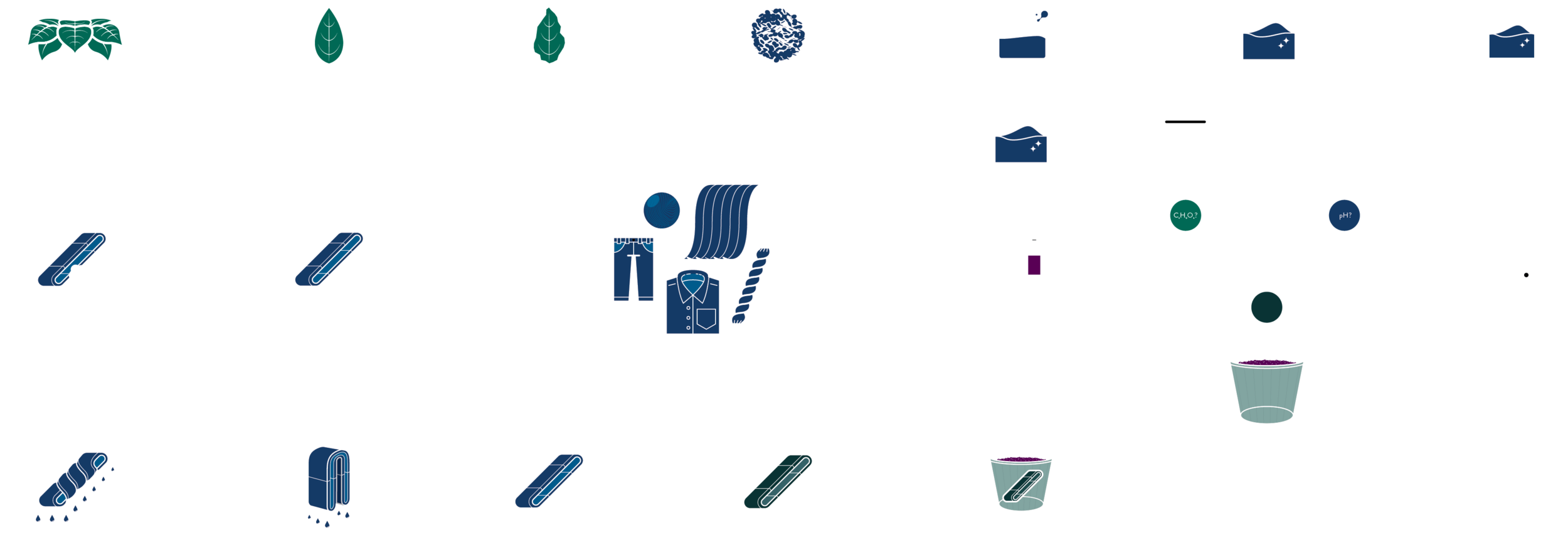Discovering Indigo Dyeing
While at Tama Art University (Tamabi) I was required to create a research project that focused on traditions of Japan. In my search I met Bryan. Bryan Whitehead has been practicing natural japanese indigo dyeing for 26 years. I initially contacted him to better understand the natural indigo process, but he ended up hiring me to work on his farm to prepare it for his workshops. Bryan jump-started my research, and told me to expand on my breadth of research. He recommended that I start my own indigo vat, and explore other indigo dyers in the area. So I read a book about meaningful patterns in textiles, kept my vat running for 6 months, and went to the open air museum, called Nihon Minka-en to talk to their experts. i began to understand the indigo vat process, and that the vat becomes a living thing.
Japanese Indigo Production Process
The Indigo Vat is Alive
It's always growing –– Part of the indigo dyeing process is getting the solution to anerobic (without any oxygen). You do this by starting a fermentation process with the indigo vat. By introducing decomposing matter and sugars, the vat develops healthy bacteria that eats the sugars and releases the oxygen in the vat.
It's reproduces –– Sometimes you need to divide the vat for dyeing different fabric materials. By removing some of the bacteria from the vat, and slowly adding liquid dye, you can start multiplying your vats using the same bacteria cultivated from the original ferment.
It's adaptive –– The start of an indigo requires a lot of energy and heat, but once it gets into a regular state, it does not require reheating or new bacteria cultivation. A lot of times it will bury it’s sugar content or alkaline base at the bottom of the vat and replenishes itself when it needs that ingredient in the vat.
It gets hungry–– In order to maintain an indigo vat, you need to regularly add a fructose sugar (wheat germ), and alkaline base (burnt hay) in order to keep the anerobic solution in at pH balance between 9.2-10.5. In addition, frequently adding more indigo pigment to the vat by extracting it from the leaves.
It occurs naturally–– The ingredients required to create a successful indigo vat are all plant and mineral based that can vary based on the climate of the area of production. When a material is dyed with indigo it, it bonds to at a molecular level. Causing not only the material’s surface pigment to change, but the entire material’s pigment to change.
Its diverse––There are many plants and organisms that carry the indigo pigment across the world. The japanese pigment harvesting process is more labor intensive than the Indian process of harvesting due to the potentency of pigment within Indian indigo. The oldest textile in the world was dyed with indigo pigment in South America.
Progress Stopped
Halfway through my research, I got a call from my dad that my grandma passed away unexpectedly. I felt frozen. I couldn’t be there for my grandma’s funeral or be there for my family. So I started to asking around to different people on how do they pay respect in to their deceased loved ones in Japan.
I want to design something that actually gives the user more time to mourn, and show that indigo is a living process. I want to accomplish this with more experimentation with indigo and refining the product’s lifespan and story.
My grandma, Barb Bauer 1950's
藍花 // Aibana
The first character (Ai) means natural indigo. It does not actually describe the color of indigo, but rather the process of natural indigo dyeing. The second character (bana) means flower. When those two characters are combined they change the meaning completely. The word, Aibana, the word, refers to the distinct silvery foam that forms at the top of an indigo vat when it is healthy and ready to be used for dyeing. Just how flowers are great indicators of a healthy living plant, so is Aibana to an indigo vat. That is why I used the Japanese indigo plant flower as the center of the logo mark, encapsulated by the indigo vat.
The focus of this a brand is educate about the living process of natural indigo dyeing, and to bring that living process to other objects and processes.
Why is an indigo based brand using dark green instead of deep indigo blue as its main color? Again, the answer is rooted in the natural process of indigo dyeing. When anything is dyed in a healthy indigo vat, it will immediately come out green instead of a rich indigo color. The reason for this is that the solution has yet to oxidize and set permanently into the objects natural pigment. The indigo vat will sit at a dark green or purple color, because it is has to be an anerobic solution. After the object has time to oxidize, it will set the indigo color in on a molecular level. I want to achieve the same level of impact with this brand.
初七日 // Shonanoka
“Shonanoka” describes the period of mourning and reflection for the passing of a loved one in the japanese Buddhist tradition. Each day is a day of gift giving. That time is to focus on the people that are closest to the deceased, by providing support through helping with the burial ceremony, gifts, and dinners. After the seven-day period, the deceased is buried or cremated and the obligation is done, but the grieving process has just started. Each object brings new life and opportunity to preserve the memory of the deceased. The cap is an opportunity to start new life in indigo, the base is perfect for Toro Nagashi, and included in the package is the indigo used to dye the ring that can hold as a memory for the loved ones of the the deceased.



















